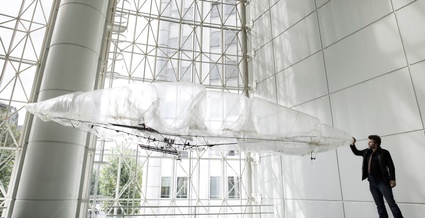 Aeromodeller 2 © Lieven Standaert
Aeromodeller 2 © Lieven Standaert
This week, i’m having a chat with Lieven Standaert, the designer behind Aeromodeller2, a work as poetical as it is ambitious and thought-provoking.
The project explores the possibility to build a 90-meter, zero-emission, airship that will never need to land to get its fuel, creating hydrogen from the elements it encounters and briefly anchoring when it needs to replenish its energy in a renewable way. Aeromodeller2 might not be the most efficient nor the fastest airship but it certainly leaves more space to imagination, dream and aspiration than anything Boeing or NASA can come up with.
A thousand airbuses jumping back and forth over the ocean twenty-four-seven. Fly, land, replace crew and passengers and take off again.
A thousand machines using up their fuel reserves in a mad, insomniac frenzy.
Until they run out…
One thousand hyperactive passenger jets, and one airship that needs to rest when its energy level is low.
Just like everything else wandering around on this planet.
The most surprising part of the project is that Lieven, just like its airship, works at his own pace. It might take him one year, ten or even more to complete his project. That’s not really the point for him. What matters is the experimental process, the constant testings, the unhurried journey made of improvements, adjustments and exploration.
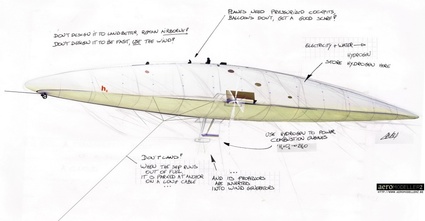 The text that describes Aeromodeller2 explains that “The project was born as a manifesto for a designer-driven innovation, as opposed to one driven by a marketing department.” What are the advantages of a designer-driven over a marketing-led approach?
The text that describes Aeromodeller2 explains that “The project was born as a manifesto for a designer-driven innovation, as opposed to one driven by a marketing department.” What are the advantages of a designer-driven over a marketing-led approach?
The school where I studied industrial design was at that time very much pushing its students towards industry. If you wanted to design a good backpack, you did focus group studies and market research and asked the people what they wanted. This is a perfectly valid thing to do, and a fittingly humble approach to design. I never liked it. My background was in architecture. My heroes were, and still are, people like Le Corbusier and Buckminster. I like the arrogant, aristocratic designers who say: “I’ve studied this problem. This is the right solution and we should build this.”
There are fields, like ergonomics, where user feedback is invaluable, but if you’re asking a hundred people if solar panels are better than wind power, it is an illusion to think the average answer will be better than that of one expert who studied the issue. If you base your designs on the amount of people that will buy it and their opinions, you will always follow. I value visionary designers who lead. Designers who say: “I’m not making what you want, I’m making what you need. Take it”.
My government, like most, is trying to promote innovation. They’re doing this by financing R&D-projects, but those are all evaluated on the basis of their business plans. Explain how long it will take to make, who you will sell it to and to how many at what price, and you’ll get considered for funding. This approach gives you a lot of small, sensible innovations. It leads to new Tupperware. It won’t give you moon rockets. It won’t give you iPods, only a lot of iPod add-ons. It won’t give you high-speed reclining bikes, jet packs or stair-climbing wheelchairs. You need a different kind of inventor for that, you need the stubborn idiots tinkering away a shed somewhere. You need people that are passionate about what they do and don’t give a rats what anyone else thinks. The Wright brothers never did a market study on the economical potential of non-stop transatlantic flights. They just thought flying would be the best thing ever. And it’s that passion that made them persevere when others gave up.
For me the Wright brothers were artists. They were at the cutting edge of their field and followed their hearts, put their soul into what they made. To me, asking what they did is engineering or art, is like asking if Bach’s church music is art or a functional piece of music.
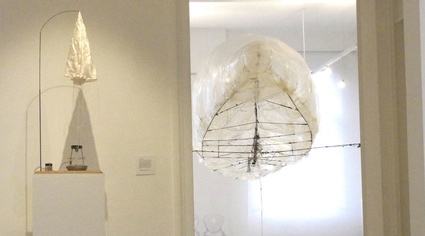 View of Aeromodeller2 as part of the ‘Machines Improbables’ at the Musée Ianchelevici, La Louvière, Belgium. On view through August 28th 2011
View of Aeromodeller2 as part of the ‘Machines Improbables’ at the Musée Ianchelevici, La Louvière, Belgium. On view through August 28th 2011
Also i note that you mention ‘design’ but could you replace the word in the sentence with art as in “art-driven innovation”? Would it impact what you try to convey with your work?
I wouldn’t use the word ‘art-driven’, it makes me think of bringing an artist into a foreign field or industry, to apply his/her ideas and visions as an innovation consultant or an added layer to this industry, This has been tried, and I don’t think it’s a very useful idea.
But what I do believe art can bring to the table is its own methodologies. Art as a methodology for innovation could be a powerful thing.
Why is the only one in the low countries who ever got his airship built, not an engineer or a company? Zeppelins have an elegance which makes designers keep going back to them. Every couple of years there’s a new concept design popping up. Why, amongst all the wild ideas for reviving airships over 50 years, is the only one who actually succeeded in building a prototype of his houseboat airship an artist?
I think that is a very interesting question, and yes, this question is part of what led me to the cross-over position where I’m now.
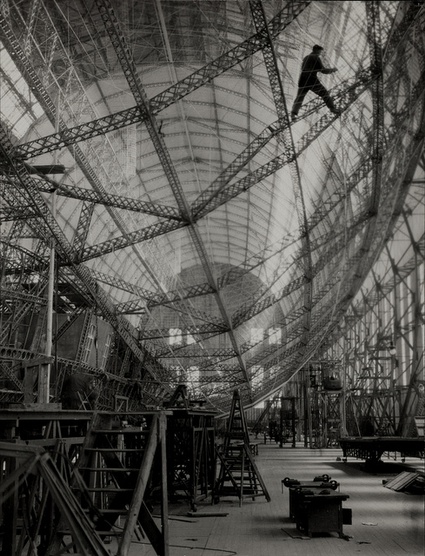 Emil Otto Hoppé, Skeleton of Graf Zeppelin, Friedrichshafen, 1928. © The E.O. Hoppé Estate Collection at Curatorial Assistance, Inc., Pasadena, California
Emil Otto Hoppé, Skeleton of Graf Zeppelin, Friedrichshafen, 1928. © The E.O. Hoppé Estate Collection at Curatorial Assistance, Inc., Pasadena, California
Artists are much more comfortable with showing experiments and failure than engineers are. Art has this culture of presenting a process, a work-in-progress. “It isn’t as good as I want it yet, but this is what I’m trying to do…” A painter, labouring for 20 years towards his perfect work. The idea also that your drawing takes shape as you work on it, as opposed to executing a finalized design. The idea of starting something you don’t know you’ll be able to finish, being ok with uncertainty. I think there is a lot of strength in those ways of working, if what you want is perseverance rather than a deadline.
Surely this must influence the way you draw up the budget necessary for the development of the project?
A traditional industrial R&D-process has a budget up front and a deadline looming at the end. You work behind closed doors and are supposed to present the finished result within time and budget. In this structure a lot of projects fail, not because you can’t make them work, but because you can’t make them work on time. Or they don’t even get started as you can’t find all the financing up front.
If I finance a project like mine against a deadline, I’m setting myself up for failure. My most precious resource is my time, as it is very hard to predict how much time we’ll need to solve unexpected problems. What I’m trying to do, by showing my experiments, by talking about a work-in-progress and explaining what I’m testing, is to put together a methodology that is less dependent on a deadline and more on slower, more sturdy growth.
I believe that if you’re prepared to fail in public, to show your dumb mistakes and what you’ve learned from them, you can grow stronger from this, and at the same time tell a more realistic, less macho, more honest story of invention.
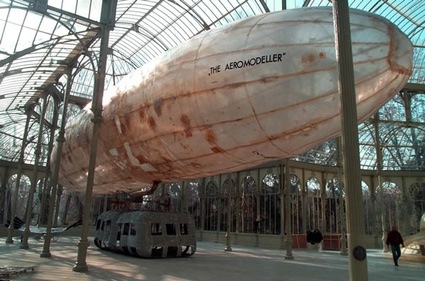 Panamarenko, Aeromodeller
Panamarenko, Aeromodeller
The reason i wanted to bring art on the table is that, unsurprisingly, i immediately thought Panamarenko when i saw your work and read its name. You also referred to Gaudi’s old models and Frei Otto’s soap bubble experiments in our previous email exchange so i guess your influences must reach much further than i expected. Can you tell us something about them and, more generally, what brought you to this ambitious project?
If you stop drawing by hand, and only use a computer, you stand to lose something. A pencil is a particular interface, you think with a pencil. You don’t think up a drawing up front, it gets created in an interplay between your hand and your head. I think most people would agree that there are aspects to a simple pencil in a well-trained hand that a computer can’t replace. I think the same holds true in building and testing stuff, in the physical experiment. Gaudi made the highest church in the world not using reinforced concrete. And he did this by building his upside-down models, using ropes under tension so find the correct shapes for the stone arcs under compression.
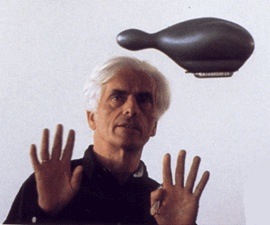 Frei Otto is the architect who designed the 1972 Munich Olympic stadium, using light-weight tent structures. At that scale, your tents are not simple canvas sheets. The sails have to be cut to follow the curve of the main cables so they don’t flop. These sails are a particular double-curved surface. He researched those by building small wire-frame models of his cables and poles, and dipping these in a soap solution. You then get these fragile, beautiful models with soap surfaces where the textile should go. It turns out the shape the soap surfaces assume is the minimum surface you want for that tent. You can measure those shapes and reproduce them for your large tent structures. There’s a picture in his ‘Seifenblasen’ book showing he experimented with instantly freezing those soap bubbles, it looks absolutely amazing.
Frei Otto is the architect who designed the 1972 Munich Olympic stadium, using light-weight tent structures. At that scale, your tents are not simple canvas sheets. The sails have to be cut to follow the curve of the main cables so they don’t flop. These sails are a particular double-curved surface. He researched those by building small wire-frame models of his cables and poles, and dipping these in a soap solution. You then get these fragile, beautiful models with soap surfaces where the textile should go. It turns out the shape the soap surfaces assume is the minimum surface you want for that tent. You can measure those shapes and reproduce them for your large tent structures. There’s a picture in his ‘Seifenblasen’ book showing he experimented with instantly freezing those soap bubbles, it looks absolutely amazing.
Today you can do all that with computer simulations, and evaluating a structure will be faster and more flexible. But what interests me is the use of these physical simulations as a design tool. As with that pencil, I think something gets lost when engineers stop tinkering about. I would be the last to deny computers have created fantastic new possibilities, I’ve worked with them professionally for years. But for me, to develop a feeling for how a tensegrity structure will deform, nothing works as well as a hot-glued sticks-and-rope model, a physical model I can touch and push against.
For the airship I wanted to study how you could create shapes by partially filling balloons, instead of using pressurized cigar shapes. The shape would be generated by the lift force of the gas, wanting to go up, as opposed to the pressure in a spheroid balloon, pushing the walls out. Now, it’s quite hard to do this with gas in a table-top-sized model. In small volumes the forces become too tiny to be practical. So what I did was, I turned my airship model upside-down, and filled it with water. The weight of the water acts as a simulant for the buoyancy of the lift gas. This gave me shapes to play with. It allowed me to test how different balloons could interact and slide over each other. I could try out different cut-patterns for the containing bags, see how they can fold open and contract, how their shapes change as they’re filled to a different degree.
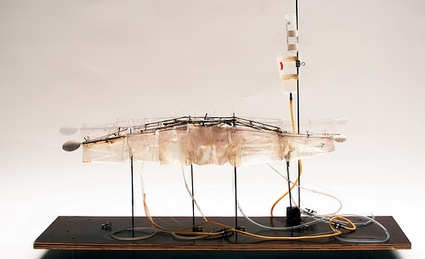 Hydrostatic model for gasbag design, using liquids to simulate the lift gas
Hydrostatic model for gasbag design, using liquids to simulate the lift gas
I believe building physical models keep you solidly grounded in reality. It’s too easy to draw stuff on a computer that simply can’t be built. And in doing experiments, you can try out stuff that you don’t understand. You can be surprised by a result, and afterwards discuss it and learn what was going on. A computer can’t replace that. You can do a wind tunnel simulation on a desktop pc, only you need to understand all the variables you put into the computer. Otherwise what comes out will be garbage. But anyone can put his hand out of the window of a driving car and feel the wind pushing on it.
That’s where I want to link back to Panamarenko. What he did in a unique way, what I love in his work, is the way he showed experiments, condensed to a single idea. The essence of experimenting is curiosity, ‘Let’s try this and see what it does’ and this is what he captured in his best works. Experiments are about failing and learning from these failures, and that is a story engineers are remarkable bad at communicating. The essence of technology is in research, is the experiment, is the process, not the final waxed car.
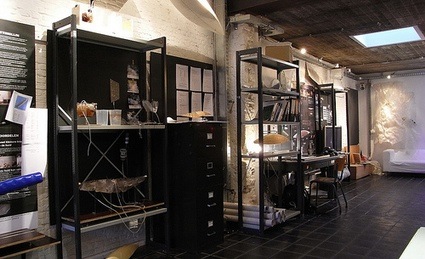 First exhibition at Expozone, Antwerp
First exhibition at Expozone, Antwerp
Has Panamarenko ever seen and reacted to your work?
I sent Panamarenko an invitation to my first exhibition, where I published the work. The expo was in Antwerp, his home town, and I was showing a houseboat airship in an arts centre. I never got a reply, but I suppose he has better things to do. He had already retired then. He was the elephant in the room anyway. I felt I had to deal with that up front, and called the expo ‘aeromodeller2’. As you know ‘aeromodeller‘ was the name he gave to his airship. It was a bit a provocation, but mainly I wanted to affirm my love for his old work. I knew I didn’t want to get the headline ‘Antwerp architect designs airship that DOES work’ I didn’t create my project as a critique on his work and I didn’t want it interpreted that way. If you baptise your boat the ‘Kontiki 2′, everyone knows you like Thor Heyerdahl. Panamarenko’s hands-on prototyping was an inspiration, in a context where hundreds of crazy airship concepts never got off the paper.
In science, when you create something new, you mention your sources, you mention the people whose work you’re building on. Not doing so is dishonest and this is what felt right to me. After the expo, the name stuck to the project, so I kept it. And here’s an interesting thing: if I talk to scientists and engineers about this, everyone agrees it makes sense and it’s a good name. If artists ask me about it, almost every single one of them tells me I should never mention Panamarenko, dump the name altogether and ‘stand on my own two feet’.
I’m a bit a stranger here myself, I’m not an artist by training, I’m not sure where I belong, but there is definitely a cultural difference between science and art in referencing your sources. There are days I wished I had chosen a different label, and I’ve been called ‘Panamarenko rip-off’ on several occasions, but never by anyone who took more than 2 minutes to look at my work. If I hadn’t had the solid confidence that my work stands on its own, I would never have dared give it this name.
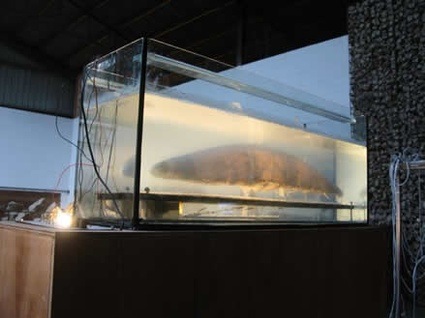 Model filled with alcohol, in tank filled with water, scale 1/100th
Model filled with alcohol, in tank filled with water, scale 1/100th
Now i think i’d need more details about the technology behind Aeromodeller2. The vehicle ‘regenerates its fuel, creating hydrogen from wind power and the rain on its skin.” Why isn’t it powered by the sun like so many flying prototype i read about then?
In order to answer that I have to tell you about hydrogen gas first. We’ve stopped using it in airships over 70 years ago. It is lighter than air, but also flammable. Today though, a number of people are reconsidering this, as we’re using the same gas as a clean fuel in cars. It’s harder to use than batteries, and less efficient, but the cars exist and we can use them safely.
The reason people keep trying to make it work, is because the principle behind it is very beautiful. You start off with water, you put an electric current through it and you will split the H20 into H2 and 02. O2 is oxygen, you let that part go, H2 is hydrogen. Hydrogen is a flammable gas with the unique property that when you burn it, it turns back into water. If you use it as a fuel, what comes out of the exhaust is clean water.
So you have this very elegant chemical reaction where you start off with water, put energy into it to make a fuel out of it, which turns back into water when you use the energy contained in it. It’s a closed cycle without any need for toxic chemicals or heavy metals, using the most abundant molecule on the planet. We’ve known about this for over 100 years, and we’ve been trying to use it ever since.
Now I’m arguing the problem with those hydrogen cars is that you’re misusing this principle. The cars only consume the hydrogen. This means they need hydrogen refueling stations, which don’t exist. It also means that they miss the essence of this idea, namely that it is a reversible, cyclic system. If you put hydrogen in a car, you’re saying to the world that hydrogen is a clean fuel, it is a replacement for gasoline. And it is not. You have to make it first. If the electricity for creating the hydrogen is generated by a coal-firing plant, it is not clean energy at all! Hydrogen is not a fuel; it’s a fantastic, light-weight battery. It is not an energy source, it is an energy carrier.
What I’m proposing is a vehicle that can generate its own hydrogen, store it and later use it as fuel for propulsion. That would result in an airship that is both a lot more autonomous, wouldn’t need refueling stations, and could fully demonstrate the beauty of this water-to-hydrogen-to-water reaction. You would have a true zero-emission zeppelin, with the autonomy of a sailing ship.
The basic principle is that I equip my airship with 2 large propellers. It can fly with those, using hydrogen as fuel. When it runs low on hydrogen, it does not land to refuel. Instead it anchors at a cable, like a kite. The propellers now start working as wind generators. They create electricity. You get water from captured rain or a lake. Electricity and water gives you hydrogen. You have the ship recharging for one or two days, and then you lift anchor and fly on.
Now, you could implement the same idea using light-weight, high-efficiency solar panels and have a continuous system. You wouldn’t need to stop. This kind of design does exist as concept drawings from several companies, but they’re extremely expensive to build and won’t get realized, not with the present state-of-the-art. They only exist as computer renderings, not as prototypes. The largest solar-powered airship is a French student project that’s just big enough to carry one man. I wasn’t interested in making pretty design drawings. I wanted to take this elegant idea of a hydrogen-based energy cycle, and implement it in a design at a scale and cost level that it could actually be built. I wanted to take this blue-sky, radical concept and develop it in the most down-to-earth, practical way possible. Because of this, the shape of my airship is designed to be built from smaller parts on ground level, like a tent structure, and the wind rotors originally were put on there because, unlike solar panels, they’re perfectly affordable and much more low-tech.
But in placing those wind generators on the concept, it grew into something else. I now had a machine that had to rest in order to regenerate. I had designed a zero-emission machine that, in order to renew its consumed energy, had to go to sleep. It grew into this biomimicry model, of a machine dealing with energy in the same way as a living being, a machine that at the end of the day has to pay the price for the energy it used up. I think that’s a very powerful idea, telling a story about energy as a finite resource instead of an unlimited supply, and I think this version is better than the solar-powered one.
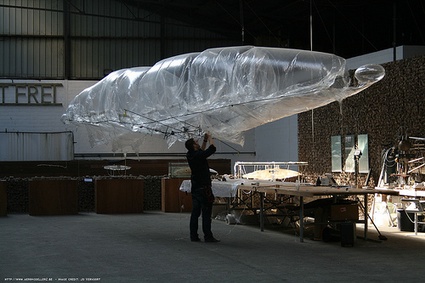 The 9-meter-model during construction/development at the Verbeke Foundation, 2009-2010
The 9-meter-model during construction/development at the Verbeke Foundation, 2009-2010
 Verbeke Foundation, exhibition “Bioart”
Verbeke Foundation, exhibition “Bioart”
How long have you been working on the model and how much work is left before you think that you’ve achieved what you were dreaming of?
I never finished those studies in industrial design, as I left to start a company with two friends. So I never did a thesis project as a designer. In the years that followed this airship idea slowly took shape. It got under my skin and I kept going back to it. It established itself as something I saw as my master thesis, as something I could use to take a position on what I kind of designer I wanted to be, and I worked on the concept verification in my free time. It’s hard to point at a specific origin, as it isn’t as much one concept, but a puzzle of ideas that over time fit together into something that was more than the sum of its parts. In 2007 I did a series of combustion tests on 10m³ hydrogen balloons to see if you could develop a balloon system to use hydrogen safely. I realized nobody had actually done those kind of experiments in a serious way, as the idea was completely marginalized by the old Hindenburg disaster. In 2009 I got to the point where I believed I could convincingly argue this concept was feasible, so I published it in a solo exhibition in order to do so. This led to the opportunity to show the work in other exhibitions, and to build the remote-controlled 9-meter-model at the Verbeke Foundation, and the project has been my main focus since.
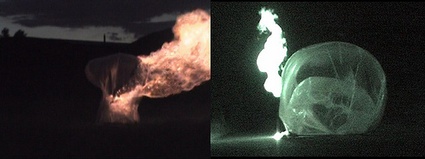 Combustion tests on 10m³ hydrogen bags
Combustion tests on 10m³ hydrogen bags
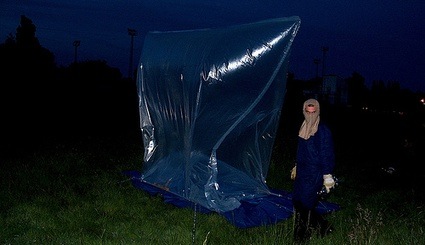 Combustion tests on 10m³ hydrogen bags
Combustion tests on 10m³ hydrogen bags
People keep asking me how long it will take me to build the full-scale airship. I have a couple of timelines written out, including one where I have all the funding I could wish for. So I used to give an answer, with a definite timing and budget, then tried to explain that it’s more complicated than that. That the whole point was deciding what you do when you don’t have all the money you wish for and you need to manage your resources. Be small. Cut the big project in little pieces and realize one piece at a time, but get it off the paper somehow. That when you want to build something radically new, any deadline is a guesstimate and your time is your most precious resource and you should protect it by developing methodologies that focus on endurance instead of on a deadline. Show your work-in-progress, instead of building behind closed doors. Show an R&D-process instead of an end result and grow slowly…
I recently realized I can give a simple, one-sentence answer. And it is: “As long as it takes…” Like a painting, it will be finished when it’s darn well good enough. I’m chasing an idea I’m passionate about and think is worthwhile working on. If it takes 10 years to get it done, then it takes 10 years. That’s how it is.
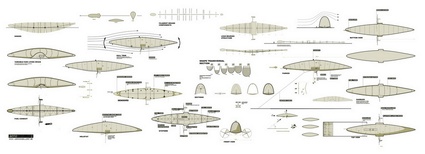 CAD-drawings
CAD-drawings
Finally, i was interested in the scenario behind Aeromodeller2. Would people live on it, use it as a refuge in case of natural or man-caused disasters or would it be rather a vehicle for travels? Or would it simply be a passing blimp?
Now you’re asking me the industrial-engineering question; where is it good for? What’s the application? Who will you sell it to? But what if I’m not building the fastest, the most efficient or even the cheapest solution? What if I’m building the most elegant, most beautiful solution to a problem?
What if I’m building a working airship, not for any particular use, but to tell a story? A machine that needs to sleep, that deals with energy like a living being. A story about a more responsible, more organic way of using energy. A story about an old, clean technology that’s too slow to actually be used in transport, just like sailing ships are ancient and outdated.
If I want to do that, where does it belong? Where do I belong?
I don’t want to define an application for it, because then I’m trapped again in this industrial-engineering logic of developing a product against a business plan deadline.
Let’s build it, not for a specific market, but because it’s beautiful.
Let’s build it because it has the right story to tell.
Maybe I’m shooting myself in the foot with this attitude. It certainly makes it harder to find investors if I refuse to pitch them an economical application.
But it does cut at two sides. If I want to develop a certified, licensed airship, an airship I can sell, this is a multi-million euro project. That would be like starting my own car manufacturing brand, it’s a huge enterprise. The chances I can ever pull that off are very slim.
But a full-scale, experimental, operational airship I can fly myself and show off around the world, that is a completely different order of magnitude. That is like building your own car or your own airplane in your garage. People do that all the time. I can get that kind of money and I believe I can pull that off.
I’m not interested in wild utopian visions where hundreds of these nomad ships are wandering over the globe, I’m interested in a pragmatic approach to get the first one built. An experimental ship will be limited in where it is allowed to fly. It won’t be super big, but large enough to carry a thousand kilos of supplies, a warm coat and a bed (yes, in the end I’m still an architect, this would be the ultimate tree house). Like an experimental airplane, it won’t be allowed to fly over any densely populated areas. And if you want to come on board for dinner, I’ll have to make you sign a waiver. But even if I’m only allowed to travel over international waters, there are a whole lot of interesting places we could visit…
Thanks Lieven!

This Summer the 9-meter-model of Aeromodeller2 is participating to the exhibition Machines improbables, on view at the Musée Ianchelevici. The show is part of the ARTour Biennale in La Louvière, Belgium and runs through August 28, 2011.
Videos of the Aeromodeller 2 project.
All images courtesy Lieven Standaert.
